Abstract
Given the real problem of climate change and the consequent need to reduce greenhouse gas emissions, nuclear energy can be considered a real technological option in the absence of a technology that can supply the population with sufficient electrical energy in a sustainable way. The research and development advances of new nuclear reactor designs are evident in the case of Small Modular Reactor (SMR) technology. Two goals are clear in such a technology: (i) reducing onsite construction costs and time; (ii) promoting economic efficiency through the mass production of nuclear reactors. In view of the interest generated by this technology, a technical summary of PWR-SMR design is included in this paper, utilizing the scientific method based on: (i) a bibliometric review of scientific publications related to SMRs; and (ii) a technical analysis of aspects of the different PWR-SMR designs. The results obtained in the present research show a growing interest on the part of the scientific community in research on PWR reactors integrated within SMR designs. Few countries are doing research in this area; however, those that are doing so have achieved greater technological advances in their designs, resulting in greater technological variety and a higher degree of maturity.
1. Introduction
Climate change and sustainable development have become real problems, so it is necessary to find specific solutions in a short period of time [1]. The atmospheric concentration of CO2 has increased in the last 50 years by more than 30%. Deforestation accounts for 11% of greenhouse gas (GHG) emissions. The Conference on Climate Change of the United Nations, celebrated in Paris in 2015, established the aim of limiting the temperature increase in the 21st century to below 1.5 degrees Celsius [2].
This climate crisis adds to the international instability regarding the scarcity of energy resources, mainly caused by the following factors (Figure 1): (i) rising hydrocarbon prices [3,4,5]; (ii) limitations placed on Russian gas exports as a result of the war between Ukraine and Russia [6]; (iii) rising international price inflation [7]; (iv) the impossibility of supplying all the electricity demanded worldwide from renewable energy sources [8]; and (v) scarcity of energy resources [9,10,11].
In view of the above situation, the discussion on the sustainability of the energy system in different countries has been reopened. This debate includes a discussion on the role of nuclear energy as a source of electricity generation in the future to achieve stability in terms of electricity generation sources, as well as the longed-for climate neutrality.
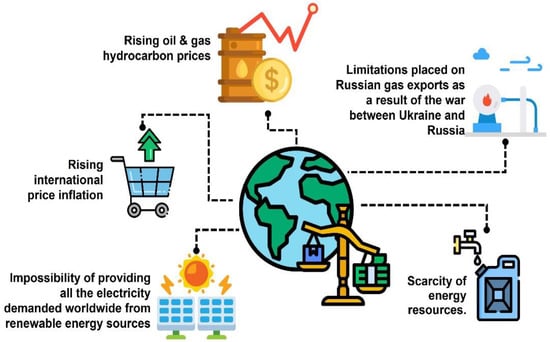
Figure 1.
Influential factors in the current international instability due to the scarcity of energy resources.
Following the accident at the Japanese Fukushima Daiichi nuclear power plant in 2011, nuclear energy suffered a period of social rejection [12], which led to the development by different countries such as Spain, Belgium, and Germany of strategies to close the nuclear power plants operating in their respective territories, increase the installed power of renewable technologies, and thus abandon nuclear energy as a source of electricity generation. This rejection of nuclear technology was also due to the high expectations generated by renewable power generation technologies, such as wind and photovoltaic [11]. However, the current scenario of international energy instability (Figure 1) has revived expectations for the development of nuclear energy as a source of electricity generation [13].
These expectations are manifested in the increase in the number of nuclear reactors under construction, as well as in the extension of the lifetime of existing reactors or the development of new nuclear reactor designs. Currently, more than 400 nuclear reactors are in operation around the world, and about 40 are under construction. Different countries, such as the United Arab Emirates, Bangladesh, or Turkey, are now betting on the incorporation of nuclear energy as a source of electricity generation in their different energy mixes, while other countries, such as the United States, France, or China, continue to bet on nuclear technology as a priority source of electricity generation [14].
From a political perspective, this commitment to nuclear technology has recently manifested itself in the European Union with the approval of the Green Taxonomy. This taxonomy includes nuclear technology as one of the technologies that can help reduce dependence on fossil fuels and thus reduce GHG emissions [15]. With this taxonomy, the European Union encourages investors to invest in nuclear technology by creating a favorable regulatory and economic framework [16]. From a technical point of view, the nuclear industry is leaving behind the large nuclear reactor designs included in the previous Generations II, III, and III+ and betting on the development of small modular nuclear reactors, known as Small Modular Reactors (SMR) [17] (Figure 2).

Figure 2.
Evolution of Generations of nuclear reactors.
SMRs are nuclear reactors with innovative designs [18], with a power generation capacity of less than 300 MWe. Among the advantages of these SMR designs, compared to previous nuclear reactor designs, are: (i) lower economic investment [19]; (ii) shorter construction times; (iii) greater flexibility at the time of implementation [20,21,22]; (iv) greater profitability [23]; and (v) greater safety [24]. Increased safety is achieved through the incorporation of passive safety equipment and systems, i.e., systems that do not require electrical power to maintain their functionality. As for the financial investment involved in their implementation, the financial risk is low compared to the high investment involved in a conventionally designed reactor [25,26].
Finally, SMRs also offer high flexibility in construction [27], which means a considerable reduction in construction time compared to Generation II and III nuclear reactor designs. In terms of operation, SMRs are characterized by their versatility and high possibilities for hybridization with other energy technologies or other applications [28]. Among the applications of SMRs, these can be grouped into (Figure 3): (i) electric power generation [20,22]; (ii) marine propulsion, as well as floating nuclear power plants [29,30]; (iii) district heating [31,32]; and (iv) other industrial applications [8,33] (desalination [34], hydrogen generation, oil extraction, or thermal energy generation for use in industrial processes).
Like the commercial reactors developed in Generations II and III, SMRs can be classified according to technology. Thus, nuclear reactors can be classified according to the main technologies into the following categories: [35] (Figure 3): (i) light water reactors; (ii) pressurized heavy water reactors; (iii) high-temperature gas-cooled reactors [36]; (iv) molten salt reactors; (v) liquid metal-cooled reactors; and (vi) fast neutron reactors. Within the first category, light water reactors, one can find Pressurized Water Reactors (PWR) and Boiling Water Reactor (BWR).
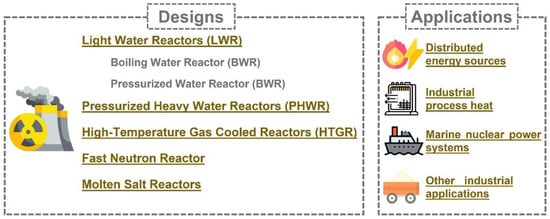
Figure 3.
Technological classification of the different SMR designs.
The PWR design has been the most developed nuclear technology for electric power generation, and there are currently more than 300 reactors with this technology in operation and more than 30 reactors under construction [14,17]. In addition, within SMR technology, there are several PWR projects under construction, such as CAREM25 (Argentina) [14].
SMR are defined as nuclear reactors with an electric power generation capacity of less than 500 MWe and typically in the range of 100–300 MWe. In a conventional PWR-design nuclear power plant, there are two fundamental cooling loops (Figure 4): (i) the primary loop; and (ii) the secondary loop, or steam cycle.
Each primary loop has the necessary piping to circulate the coolant inside it, a reactor coolant pump (RCP) to drive the coolant, and a heat exchanger called a steam generator [17]. In one of these primary loops is installed the pressurizer, whose function is to control the process pressure (Figure 4). In the reactor vessel, a fundamental component of the primary circuit, nuclear fission occurs, causing the coolant temperature to rise, which initially circulates the fuel element sheaths and subsequently through the primary circuit [37]. In the steam generators, the heat energy of the coolant is transferred at high temperatures to the water circulating on the shell side of the exchanger until it changes its state to steam. Subsequently, this steam is used in a turbine to transform its heat power into rotational speed and, in turn, into an electrical output voltage for the alternator [17]. PWR-type SMRs integrate into their compact design the fundamental components of the conventional PWR design (Figure 4): (i) reactor vessel; (ii) pressurizer; and (iii) steam generators, although there are certain technical differences in terms of integration and distribution of components [38].
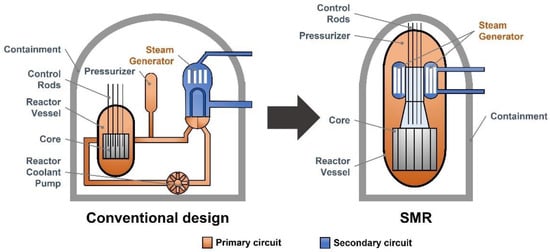
Figure 4.
Integration of a conventional PWR design in an SMR.
Different authors have made scientific reviews of the development of conventional nuclear reactors [39] as well as PWR technical variants [17]. In the case of SMR reactors, global reviews have been found [40], as have reviews of the requirements [41] and technical [42], economic [43,44,45], and social [46] impediments to their development, of safety systems [47], and of the evolution of off-site modular construction [48]. Other authors are even critical of its development [49]. However, no studies combining bibliometric and technical analyses of PWR reactors integrated within SMR technology have been found. Given this scenario, the present article aims to analyze the technical advances developed in PWR reactor designs for electric power generation integrated within SMR technology. For this purpose, this article develops a bibliometric review and technical summary of PWR designs integrated into SMR technology. The motivation to combine the bibliometric review and the technical summary is to help the scientific community identify interest in the topic as well as assist in the technical analysis of the main PWR designs included in the SMR technology.
2. Materials and Methods
To achieve this objective, a combined methodology is developed in this research (Figure 5), in which first a bibliometric review of the scientific publications related to PWR designs included in the SMR technology is carried out, followed by a technical summary of the different variants of the PWR reactors included in the SMR technology, as well as a study of the level of development and implementation of the different PWR reactors around the world.

Figure 5.
Scientific Methodology Outline.
The bibliometric review methodology used here is relevant for the purposes of this research because it provides a categorized view of the different papers published in the field under review [50]. The data were collected in April 2023 from the Scopus database, one of the most important and widely used bibliographic databases. To filter the results and obtain a refinement of the searched terms, different Boolean operators and search criteria were used. First, a searching string (“Small Modular Reactor” or “SMR”) and (“Pressurized Water Reactor” or “PWR”) was performed. The results yielded a total of 683 bibliographic materials. Secondly, the search (“Nuclear Energy"), “Small Modular Reactor” or "SMR"), and “Pressurized Water Reactor” or “PWR”) was performed, yielding a total of 82 bibliographic materials.
After applying the two search criteria, in view of the greater number of results obtained, it was decided to analyze the results obtained in the first search (“Small Modular Reactor” or “SMR”) and (“Pressurized Water Reactor” or “PWR”). The collected data were processed using the software VOSviewer® 1.6.16 (developed by Leiden University, Netherlands) to present some of the possible results in a graphic way. The study used simultaneous publication by year, productivity, sources across countries, keyword trends, and co-citation. Figure 6 below illustrates the annual trends in the publication of papers in this field.
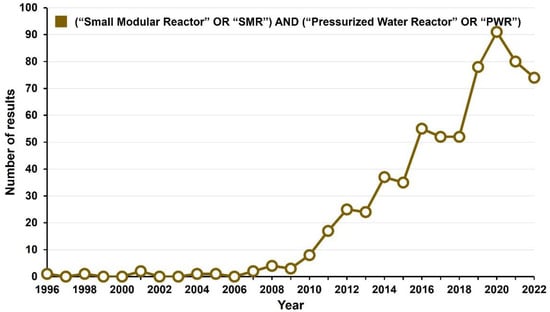
Figure 6.
Publications by year (1996–2022) (data collected from Scopus database in May 2023).
Keyword co-occurrence by author measures the most commonly used keywords in the papers. Co-authorship indicates the volume of publications for a set of variables and how they are connected [51]. Finally, "co-citation" is defined as two papers being cited by the same third paper [52].
3. Results
This section presents the results obtained in the present investigation. Firstly, the results of the bibliometric analysis are shown. Secondly, the technical analysis of the different PWR reactor designs included in the SMR technology and their implementation is shown.
3.1. Bibliometric Analysis
Following the previously mentioned search string, the first article related to SMR nuclear reactors identified in the SCOPUS database is from 1996 [53]. This article develops the concept of a Small Modular Reactor with a suspended core. Publications on the subject became regular from 2007 onward. In view of Figure 6, it can be seen how the number of publications has grown substantially since then. Two distinct periods can be observed: (i) up to 2008 (no interest in SMR technology by the scientific community); and (ii) 2008–2020 (an increasing trend in the number of publications). It is worth noting that the last two years, 2020–2022, show a decreasing trend, but it may be that not everything researched in that time has been published yet.
As for annual productivity, less than 5 articles per year were published between 1996 and 2009; even between 1997 and 2000, no article related to the search was published. From 2009 on, the number of published articles has grown linearly. In 2013, 24 articles were published, 27 in 2014, and 35 in 2015. In 2016, 55 articles were published. The number of publications peaked in 2020, with 91 articles published. Of the 683 results obtained, 92% were published in journals and conference proceedings. Analyzing the sources from which the 683 results were published, it is possible to observe that more than 80 different sources exist (Table 1).

Table 1.
Summary of productivity of sources (1996–2022).
Of the 88 sources, 63.7% publish only one result, while only 21.6% publish five or more results, which is an indicator that there are few specific sources on the subject. Among the most used sources, with more than 20 results, “Annals of Nuclear Energy” (89 results), “Progress in Nuclear Energy” (59 results), “Nuclear Engineering and Design” (57 results), “International Conference on Nuclear Engineering Proceedings ICONE” (48 results), “Nuclear Engineering and Technology” (25 results), and “Energies” (22 results) stand out, which accumulate 300 results, that is, 46% of the results obtained in the search.
Figure 7 presents the co-citation map of the sources where scientific articles related to the subject are published. There are three groups: one led by “Annals of Nuclear Energy,” with an impact score of 1.81, one of the main research journals in the field; another led by “Nuclear Engineering and Design,” with an impact factor of 1.9; "Energy,” with an impact factor of 8.857; and finally, a third group led by “Progress in Nuclear Energy,” with an impact factor of 2.461.
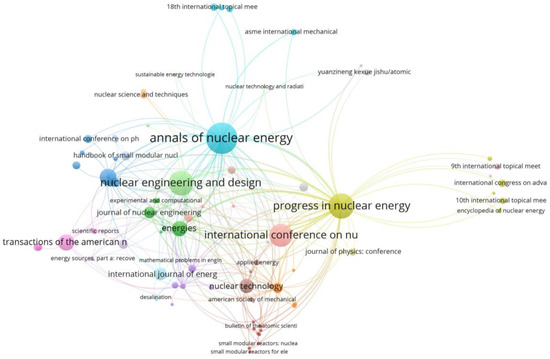
Figure 7.
Co-citation of journals. Source: developed by the authors in VOS Viewer software 1.6.16.
The 683 articles are divided into 19 areas, with Table 2 highlighting those with more than 10 results. The “Energy” category is the main category, with 568 associated articles, equivalent to 83% of the total. The second category with the most associated articles is "Engineering,” with 282 articles, followed by “Physics and Astronomy,” with 174 articles.
Analyzing the country of affiliation of the authors, the 683 papers are distributed in more than 50 countries. This means that at least one paper has been published in each of these countries. The top 10 countries that have published the most academic papers in the field of research are listed in Table 3; together, they exceed 90% of all published articles. According to the data, the United States is the country with the highest number of publications, with a total of 201 results, followed by China, with 153 articles, and South Africa, with 122 articles.
Regarding the analysis of keywords through co-occurrence, the most frequently used keywords were identified and analyzed to classify the 683 articles in the sample. From this analysis, the most frequently occurring topics in the analyzed area stand out [54]. Of the 351 results found, 4692 keywords were identified. Of these, 3335 words appeared only once, which represents a prevalence of 71.1%. Another 370 keywords appeared more than five times or 7.8%; 49 keywords were identified in at least 20 articles, or 1%; and only 15 keywords (“small nuclear reactors," “small modular reactors," "nuclear power plants," “nuclear fuel," “nuclear energy," “small modular reactor," “light water reactor," "smr," "fuels," “steam generators," “nuclear reactor accidents," "design," “safety engineering,” and “heat transfer”) appeared more than 50 times, or 0.32%. The keyword “small nuclear reactors“ has 419 occurrences, making it the most used word.
The map shown in Figure 8 groups the keywords into 14 clusters. A cluster is a set of closely related terms. Cluster I (150 items) covers topics related to PWR SMR reactor safety, such as fuel and coolant. Cluster II (130 items) contains items related to design, mechanical stability, and design constraints. Cluster III (111 items) includes aspects related to high-temperature gas reactors, electricity demands, cycle efficiency, etc. The main keyword is “small nuclear reactors” (Cluster V, purple). Cluster II (dark green) highlights other keywords like “nuclear energy," “safety engineering,” and “nuclear power plants".

Table 2.
Number of publications by area (1996–2022).
Table 2.
Number of publications by area (1996–2022).
| R | Area | Results | Percentage |
|---|---|---|---|
| 1 | Energy | 568 | 83.1% |
| 2 | Engineering | 282 | 41.3% |
| 3 | Physics and Astronomy | 174 | 25.5% |
| 4 | Environmental Science | 141 | 20.6% |
| 5 | Material Science | 72 | 10.5% |
| 6 | Mathematics | 41 | 6.0% |
| 7 | Computer Science | 29 | 4.2% |
| 8 | Chemical Engineering | 14 | 2.0% |

Table 3.
Countries ranking (1996–2022).
Table 3.
Countries ranking (1996–2022).
| R | Country | Results | % of 683 |
|---|---|---|---|
| 1 | United States | 201 | 29.4% |
| 2 | China | 153 | 22.4% |
| 3 | Republic of Korea | 122 | 17.8% |
| 4 | Iran—United Kingdom | 47 | 6.8% |
| 5 | Canada | 34 | 4.9% |
| 6 | Italy | 22 | 3.2% |
| 7 | France | 16 | 2.3% |
| 8 | Germany | 15 | 2.2% |
| 9 | Brazil—Japan | 11 | 1.6% |
| 10 | Indonesia—Nigeria—Sweden | 8 | 1.2% |
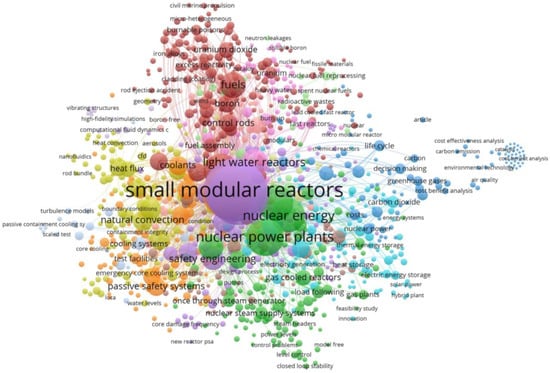
Figure 8.
Keyword trends and cluster structure (1996–2022). Source: developed by the authors in VOS Viewer software 1.6.16.
The analysis performed around the PWR SMR reactors revealed several directly connecting terms (Figure 9). The term “small nuclear reactors” (Cluster V) has a total of 419 occurrences with a total link strength of 5178, connecting with terms like “fuels” and “control rods” (Cluster I), “load following” and “nuclear steam supply systems” (Cluster II), “life cycle” or “carbon dioxide” (Cluster III).
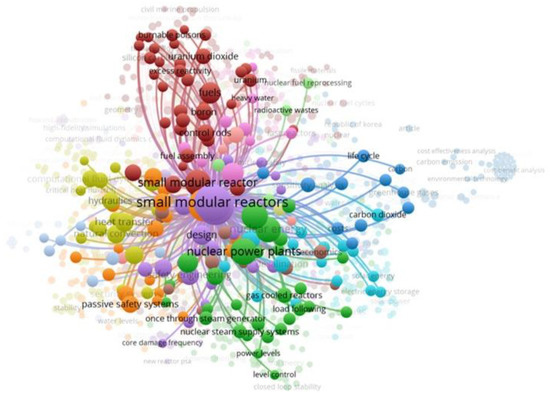
Figure 9.
Cluster’s structure (1996–2022): links between the research interest in Small Nuclear Reactors with safety trends. Source: developed by the authors in VOS Viewer software 1.6.16.
3.2. Technical and Development Analysis
This section shows the study of the technical aspects of PWR-SMR designs. The following Table 4 shows the different PWR designs integrated into SMR developed around the world. As can be seen, the different PWR reactor designs included in SMRs, their electrical power generation capacity (MWe), their developer and country, application, and state of development are included.
Having classified the different PWR designs integrated into SMRs, the following is a technical development of those that have been designed with the objective of being implemented in terrestrial nuclear power plants [55].

Table 4.
Distribution PWR design evolution in SMR [55].
Table 4.
Distribution PWR design evolution in SMR [55].
| Denomination Design | Capacity (MWe) | Developer (Country) | Application * | State of Development |
|---|---|---|---|---|
| ACP-100 | 125 | CNNC (China) | NPP | Under construction |
| CAREM25 | 27 | CNEA & INVAP (Argentina) | NPP | Under construction |
| CAP200 | 220 | SNERDI/SPIC (China) | NPP | Earlier stages |
| CNP-300 | 300 | SNERDI (Pakistan) & CNNC (China) | NPP | Operating |
| IMR | 350 | Mitsubishi (Japan) | NPP | Inactive |
| IRIS | 335 | International team | NPP | Inactive |
| mPower | 195 | Babcock & Wilcox (United States) | NPP | Suspended |
| NuScale | 77 | Nuscale Power (United States) | NPP | Near-term deployment |
| SMART | 100 | KAERI (Republic of Korea) | NPP | Near-term deployment |
| SMR-160 | 160 | Holtec (United States) & SNC-Lavalin (Canada) | NPP | Near-term deployment |
| SNP350 | 350 | SNERDI (China) | NPP | Earlier stages |
| UK SMR | 470 | Rolls Royce SMR (United Kingdom) | NPP | Earlier stages |
| W-SMR | 225 | Westinghouse (United States) | NPP | Earlier stages |
| ACPR100 | 140 | CGN (China) | FNPP | Earlier stages |
| ACPR50S | 60 | CGN (China) | FNPP | Near-term deployment |
| BANDI60S | 60 | KEPCO (Republic of Korea) | FNPP | Near-term deployment |
| KLT-40S | 35 | OKBM (Russia) | FNPP | Operating |
| RITM 200 (Russia) | 50 | OKBM (Russia) | FNPP | Operating |
| VBER-300 | 300 | OKBM (Russia) | FNPP | Near-term deployment |
* Application: NPP. Nuclear Power Plant; FNPP: Floating Nuclear Power Plant.
3.2.1. American PWR-SMR Design
The Westinghouse SMR is an 800 MWt and 225 MWe integral PWR that has similarities to its predecessor design, IRIS, and to Westinghouse’s Generation III PWR, AP1000 [56]. It has passive safety systems, a 24-month nuclear fuel cycle, and a lifetime of 60 years [55].
In the case of the SMR mPower, Babcock & Wilcox (B&W) has designed an integral 500 MWt, 180 MWe PWR. This design is currently in a state of suspension. As for the SMR-160, Holtec International is developing a 160 MWe (525 MWt) reactor. The SMR-160 is passively cooled while running and after shutdown for an indefinite time, with a negative temperature coefficient. The whole reactor system would be installed below ground level, with spent fuel storage [57].
Finally, Nuscale is an integral PWR that includes a reactor vessel, two steam generators, and an integral containment. Its generating capacity is 77 MWe. It has passive coolant circulation systems, mainly through natural circulation, and different defense-in-depth systems to deal with emergencies [58,59].
3.2.2. Asian PWR-SMR Design
Mitsubishi Heavy Industries has a conceptual design for the Integral Modular Reactor (IMR), a 1000 MWt, 350 MWe PWR. It has a design lifetime of 60 years and a fuel cycle of 26 months. The design is currently inactive [47].
The SMART (System-integrated Modular Advanced Reactor), is a 330 MWt South Korean PWR reactor with integrated steam generators and advanced safety devices The expected lifetime is 60 years, with a fuel enrichment of 4.8% and a refueling cycle of three years. It has 57 fuel elements, very similar to those of normal PWRs but shorter, and operates on a 36-month fuel cycle. All safety systems are passive [60].
The CNP-300 design is based on China’s first Qinshan 1 reactor as a two-loop PWR, with four in operation in Pakistan. It has 1000 MWt, 325 MWe, and an expected lifetime of 40 years. Fuel enrichment is 2.4–3.0%, with refueling at 12-month intervals. The SNP350 design is the evolution of the CNP-300 design, improved in many respects to meet the latest performance, economics, and safety requirements [61].
The CAP200, which is being developed by SNERDI, uses proven fuel and core designs. It has 660 MWt and 220 MWe and two steam generators. designed to replace coal-fired power plants and supply process heat and district heating, with an expected lifetime of 60 years [49,62]. The ACP100, or Linglong One, has passive safety features, in particular decay heat removal [63], and will be installed underground. It has 57 fuel assemblies (2.15 m high) and integral steam generators (320 °C). ACP100 produces about 125 MWe, and two to six of these modules are planned with a design life of 60 years and a 24-month refueling period [47].
3.2.3. Other PWR-SMR Designs
CAREM25 is under construction in Argentina. It is a 100 MWt (27 MWe gross) integral modular pressurized water reactor of an older design, first announced in 1984. It has 12 steam generators inside the pressure vessel [64].
Rolls-Royce has been working on a design that was originally 220 MWe, but the focus has shifted to a mid-size reactor of 400 MWe. It would be a three-loop PWR with external steam generators attached. It would use 4.95% enriched fuel distributed in 121 fuel elements. The refueling cycle would be 18–24 months [55].
Finally, Table 5 shows the distribution of the different safety systems in the main PWR-SMR designs: (i) accumulators, whose function is to passively inject coolant into the primary in case of a loss of coolant accident (LOCA); (ii) active systems: capable of injecting coolant into the primary by means of pumps; (iii) make-up tanks: capable of passively injecting coolant into the primary and even flooding the containment building; (iv) elevated tanks: natural circulation loops of the elevated tanks; and (v) long-term core cooling: passive systems that allow the primary circuit cooling to be maintained over the long term.

Table 5.
Main parameters PWR-SMR designs [55,65,66].
4. Discussion
As can be noted in the bibliometric analysis, which deals with research published from 1996 to 2022, according to the nationality of the authors (Table 4), several countries are positioned as references in PWR-SMR research (Table 6): (i) the United States [67]; (ii) the Republic of Korea [68]; (iii) China [69]; and (iv) the United Kingdom. Considering that the growth of research results occurs globally from 2010 onwards (Figure 6), if the results obtained cumulatively between 2010 and 2022 are analyzed, it is obtained that the United States has increased its research results in this area by more than 5.3 times, while China and the Republic of Korea have increased them by more than 12 times. In the case of the United Kingdom, there has been no annual increase, maintaining the level of publications over the last 12 years.

Table 6.
Evolution of co-authorship by country (2010–2022).
These results are related to the technical development of the different PWR-SMR designs (Figure 10). The United States managed to maintain the bidding process for several of its integral PWR designs: (i) Nuscale; (ii) SMR-160; and (iii) SMR Westinghouse, while only the licensing process for the mPower design was suspended. In the case of Asia, China maintains its commitment to the ACP-100 and CNP-300 designs, while South Korea continues to develop the SMART design. Finally, Japan has no national design following the suspension of the IMR design [55].
As for the rest of the world, only the United Kingdom and Argentina are committed to the development of indigenous SMR PWR designs. In the case of the United Kingdom, the need to increase energy independence from other sources of electric power generation augurs the massive implementation of SMRs in its territory. In the case of Argentina, after many years of construction, CAREM25 is still in this phase and is expected to start operating in the next few years [55].
Other leading countries in PWR-SMR research are Canada and Iran, but they do not have their own designs with this technology. In the case of Canada, several reasons can be identified that explain this scientific interest: (i) the country is developing its own SMR designs with PHWR technology, historically developed by this country through [17], which, unlike the PWR design, has heavy water as a coolant instead of water [70]; (ii) the SMR-160 (Table 4) is being developed by Holtec (Jupiter, FL, United States) and SNC-Lavalin (Montréal, QC, Canada), the first step having been completed in 2020 by the Canadian Nuclear Safety Commission [67]. In the case of Iran, the Asian country is taking the first steps towards developing a national nuclear power program [71], in which SMR-PWR designs play a key role [72].
Thus, as can be noted in Figure 11, if research on SMR-PWR reactors is related to the technological evolution of the designs, it is possible to observe that the countries that have done the most research in this area are those that have achieved the greatest technological advances, resulting in a greater technological variety and a higher degree of maturity.
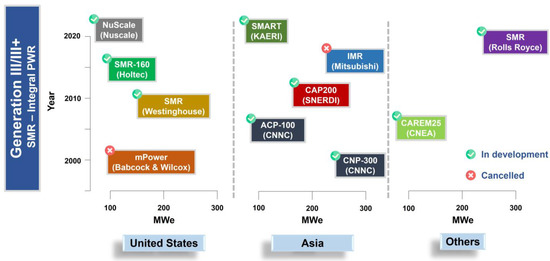
Figure 10.
Current status SMR-PWR designs.

Figure 11.
Scopus results (1996–2022) by countries and SMR-PWR design.
5. Conclusions
Advances in research and development of new nuclear reactor designs are evident in the evolution of small modular reactor (SMR) technology. SMRs are advanced nuclear reactors with a power generation capacity of up to 300 MWe per unit, which represents one third of the generation capacity of traditional nuclear reactors. SMR technology has two objectives: (i) to reduce the cost and time of on-site construction; and (ii) to promote economic profitability through the mass production of nuclear reactors.
Another of the fundamental advantages of SMR reactors is their operational versatility as well as their reduced environmental impact, which allows them to favor sustainable development and support international energy systems that include renewable energies as well as nuclear energy.
The results obtained in the present research show a growing interest on the part of the scientific community in research on PWR reactors integrated within SMR designs. The bibliometric analysis of published research shows that few countries are doing research in this area; however, those that are doing so have achieved greater technological advances in their designs, resulting in a greater technological variety and a higher degree of maturity. With a view to achieving the Sustainable Development Goals (SDGs) by 2030, the next developments in PWR SMR designs will play a key role.
If the scientific community’s interest in PWR designs integrated with SMR technology continues to grow and the nuclear industry maintains its strategy of designing, licensing and building SMR designs, it will be possible to end the current crisis of energy resource scarcity, reduce dependence on fossil fuels, and achieve the desired energy neutrality—a CO2-free energy system—by 2050.
Author Contributions
Conceptualization, P.F.-A. and D.V.; methodology, P.F.-A. and D.V.; validation, P.F.-A., D.V. and Á.A.-S.; formal analysis, P.F.-A., D.V. and Á.A.-S.; writing—original draft preparation, P.F.-A.; writing—review and editing, P.F.-A., D.V. and Á.A.-S.; supervision, D.V. and Á.A.-S. All authors have read and agreed to the published version of the manuscript.
Funding
This research received no external funding.
Data Availability Statement
Not applicable.
Conflicts of Interest
The authors declare no conflict of interest.
References
- Omar, H.; Graetz, G.; Ho, M. Decarbonizing with nuclear power, current builds, and future trends. In The 4Ds of Energy Transition: Decarbonization, Decentralization, Decreasing Use and Digitalization; Asif, M., Ed.; Wiley: Hoboken, NJ, USA, 2022; pp. 103–151. [Google Scholar]
- Santos-Iglesia, C.; Fernández-Arias, P.; Antón-Sancho, Á.; Vergara, D. Energy Consumption of the Urban Transport Fleet in UNESCO World Heritage Sites: A Case Study of Ávila (Spain). Sustainability 2022, 14, 5641. [Google Scholar] [CrossRef]
- Mahmood, H.; Asadov, A.; Tanveer, M.; Furqan, M.; Yu, Z. Impact of Oil Price, Economic Growth and Urbanization on CO2 Emissions in GCC Countries: Asymmetry Analysis. Sustainability 2022, 14, 4562. [Google Scholar] [CrossRef]
- Mohamued, E.A.; Ahmed, M.; Pypłacz, P.; Liczmańska-Kopcewicz, K.; Khan, M.A. Global Oil Price and Innovation for Sustainability: The Impact of R&D Spending, Oil Price and Oil Price Volatility on GHG Emissions. Energies 2021, 14, 1757. [Google Scholar] [CrossRef]
- Litvinenko, V. The Role of Hydrocarbons in the Global Energy Agenda: The Focus on Liquefied Natural Gas. Resources 2020, 9, 59. [Google Scholar] [CrossRef]
- Stulberg, A.N. Out of Gas? Russia, Ukraine, Europe, and the Changing Geopolitics of Natural Gas. Prob. Post Communism 2015, 62, 112–130. [Google Scholar] [CrossRef]
- Yeoman, I. Ukraine, price and inflation. J. Revenue Pricing Manag. 2022, 21, 253–254. [Google Scholar] [CrossRef]
- Gabbar, A.H.; Abdussami, M.R.; Adham, M.I. Techno-Economic Evaluation of Interconnected Nuclear-Renewable Micro Hybrid Energy Systems with Combined Heat and Power. Energies 2020, 13, 1642. [Google Scholar] [CrossRef]
- Uri, N.D. A reconsideration of effect of energy scarcity on economic growth. Energy 1995, 20, 1–12. [Google Scholar] [CrossRef]
- Ahmadi, E.; McLellan, B.; Mohammadi-Ivatloo, B.; Tezuka, T. The Role of Renewable Energy Resources in Sustainability of Water Desalination as a Potential Fresh-Water Source: An Updated Review. Sustainability 2020, 12, 5233. [Google Scholar] [CrossRef]
- Arvidsson, R.; Svanström, M.; Harvey, S.; Sandén, B.A. Life-cycle impact assessment methods for physical energy scarcity: Considerations and suggestions. Int. J. Life Cycle Assess. 2021, 26, 2339–2354. [Google Scholar] [CrossRef]
- Kessides, I.N. The future of the nuclear industry reconsidered: Risks, uncertainties, and continued promise. Energy Policy 2012, 48, 185–208. [Google Scholar] [CrossRef]
- Di Maio, F.; Bani, L.; Zio, E. The Contribution of Small Modular Reactors to the Resilience of Power Supply. J. Nucl. Eng. 2022, 3, 152–162. [Google Scholar] [CrossRef]
- International Atomic Energy Agency. Power Reactor Information System (PRIS). Available online: https://www.iaea.org/PRIS/home.aspx (accessed on 18 April 2022).
- Alessi, L.; Battiston, S. Two sides of the same coin: Green Taxonomy alignment versus transition risk in financial portfolios. Int. Rev. Financ. Anal. 2022, 84, 102319. [Google Scholar] [CrossRef]
- Tryhuba, A.; Hutsol, T.; Kuboń, M.; Tryhuba, I.; Komarnitskyi, S.; Tabor, S.; Kwaśniewski, D.; Mudryk, K.; Faichuk, O.; Hohol, T.; et al. Taxonomy and Stakeholder Risk Management in Integrated Projects of the European Green Deal. Energies 2022, 15, 2015. [Google Scholar] [CrossRef]
- Fernández-Arias, P.; Vergara, D.; Orosa, J.A. A Global Review of PWR Nuclear Power Plants. Appl. Sci. 2020, 10, 4434. [Google Scholar] [CrossRef]
- Cooper, M. Small modular reactors and the future of nuclear power in the United States. Energy Res. Soc. Sci. 2014, 3, 161–177. [Google Scholar] [CrossRef]
- Mignacca, B.; Locatelli, G.; Sainati, T. Deeds not words: Barriers and remedies for Small Modular nuclear Reactors. Energy 2020, 206, 118137. [Google Scholar] [CrossRef]
- Poudel, B.; Joshi, K.; Gokaraju, R. A Dynamic Model of Small Modular Reactor Based Nuclear Plant for Power System Studies. IEEE Trans. Energy Convers. 2020, 35, 977–985. [Google Scholar] [CrossRef]
- Ayo-Imoru, R.M.; Ali, A.A.; Bokoro, P.N. Analysis of a Hybrid Nuclear Renewable Energy Resource in a Distributed Energy System for a Rural Area in Nigeria. Energies 2022, 15, 7496. [Google Scholar] [CrossRef]
- Poudel, B.; Lin, L.; Phillips, T.; Eggers, S.; Agarwal, V.; McJunkin, T. Operational Resilience of Nuclear-Renewable Integrated-Energy Microgrids. Energies 2022, 15, 789. [Google Scholar] [CrossRef]
- Hong, S.; Brook, B.W. Economic Feasibility of Energy Supply by Small Modular Nuclear Reactors on Small Islands: Case Studies of Jeju, Tasmania and Tenerife. Energies 2018, 11, 2587. [Google Scholar] [CrossRef]
- Testoni, R.; Bersano, A.; Segantin, S. Review of nuclear microreactors: Status, potentialities and challenges. Prog. Nucl. Energy 2021, 138, 103822. [Google Scholar] [CrossRef]
- Stewart, W.R.; Shirvan, K. Capital cost estimation for advanced nuclear power plants. Renew. Sust. Energ. Rev. 2022, 155, 111880. [Google Scholar] [CrossRef]
- Vujić, J.; Bergmann, R.M.; Škoda, R.; Miletić, M. Small modular reactors: Simpler, safer, cheaper? Energy 2012, 45, 288–295. [Google Scholar] [CrossRef]
- Lloyd, C.A.; Roulstone, T.; Lyons, R.E. Transport, constructability, and economic advantages of SMR modularization. Prog. Nucl. Energy 2021, 134, 103672. [Google Scholar] [CrossRef]
- Bragg-Sitton, S.M. Hybrid energy systems using small modular nuclear reactors (SMRs). In Handbook of Small Modular Nuclear Reactors, 2nd ed.; Ingersoll, D.T., Carelli, M.D., Eds.; Woodhead Publishing Series in Energy; Woodhead Publishing: Sawston, UK, 2021; pp. 323–356. [Google Scholar] [CrossRef]
- Lee, K.-H.; Kim, M.-G.; Lee, J.I.; Lee, P.-S. Recent Advances in Ocean Nuclear Power Plants. Energies 2015, 8, 11470–11492. [Google Scholar] [CrossRef]
- Gabbar, H.A.; Adham, M.I.; Abdussami, M.R. Optimal Planning of Integrated Nuclear-Renewable Energy System for Marine Ships Using Artificial Intelligence Algorithm. Energies 2021, 14, 3188. [Google Scholar] [CrossRef]
- Värri, K.; Syri, S. The Possible Role of Modular Nuclear Reactors in District Heating: Case Helsinki Region. Energies 2019, 12, 2195. [Google Scholar] [CrossRef]
- Teräsvirta, A.; Syri, S.; Hiltunen, P. Small Nuclear Reactor—Nordic District Heating Case Study. Energies 2020, 13, 3782. [Google Scholar] [CrossRef]
- Peakman, A.; Merk, B. The Role of Nuclear Power in Meeting Current and Future Industrial Process Heat Demands. Energies 2019, 12, 3664. [Google Scholar] [CrossRef]
- Al-Othman, A.; Darwish, N.N.; Qasim, M.; Tawalbeh, M.; Darwish, N.A.; Hilal, N. Nuclear desalination: A state-of-the-art review. Desalination 2019, 457, 39–61. [Google Scholar] [CrossRef]
- Sanchez-Espinoza, V.H.; Gabriel, S.; Suikkanen, H.; Telkkä, J.; Valtavirta, V.; Bencik, M.; Kliem, S.; Queral, C.; Farda, A.; Abéguilé, F.; et al. The H2020 McSAFER Project: Main Goals, Technical Work Program, and Status. Energies 2021, 14, 6348. [Google Scholar] [CrossRef]
- Zhang, Z.; Sun, Y. Economic potential of modular reactor nuclear power plants based on the Chinese HTR-PM project. Nucl. Eng. Des. 2007, 237, 2265–2274. [Google Scholar] [CrossRef]
- Toribio, J.; Vergara, D.; Lorenzo, M. Role of in-service stress and strain fields on the hydrogen embrittlement of the pressure vessel constituent materials in a pressurized water reactor. Eng. Fail. Anal. 2017, 82, 458–465. [Google Scholar] [CrossRef]
- Pannier, C.; Skoda, R. Comparison of Small Modular Reactor and Large Nuclear Reactor Fuel Cost. Energy Power Eng. 2014, 6, 82–94. [Google Scholar] [CrossRef]
- Ho, M.; Obbard, E.; Burr, P.A.; Yeoh, G. A review on the development of nuclear power reactors. Energy Procedia 2019, 160, 459–466. [Google Scholar] [CrossRef]
- Liu, Z.; Fan, J. Technology readiness assessment of Small Modular Reactor (SMR) designs. Prog. Nucl. Energy 2014, 70, 20–28. [Google Scholar] [CrossRef]
- Chang, C.-k.; Oyando, H.C. Review of the Requirements for Load Following of Small Modular Reactors. Energies 2022, 15, 6327. [Google Scholar] [CrossRef]
- Hidayatullah, H.; Susyadi, S.; Subki, M.H. Design and technology development for small modular reactors—Safety expectations, prospects and impediments of their deployment. Prog. Nucl. Energy 2015, 79, 127–135. [Google Scholar] [CrossRef]
- Black, G.; Shropshire, D.; Araújo, K. Small modular reactor (SMR) adoption: Opportunities and challenges for emerging markets. In Handbook of Small Modular Nuclear Reactors, 2nd ed.; Ingersoll, D.T., Carelli, M.D., Eds.; Woodhead Publishing Series in Energy; Woodhead Publishing: Sawston, UK, 2021; pp. 557–593. [Google Scholar] [CrossRef]
- Vegel, B.; Quinn, J.C. Economic evaluation of small modular nuclear reactors and the complications of regulatory fee structures. Energy Policy 2017, 104, 395–403. [Google Scholar] [CrossRef]
- Black, G.; Shropshire, D.; Araújo, K.; Van Heek, A. Prospects for Nuclear Microreactors: A Review of the Technology, Economics, and Regulatory Considerations. Nucl. Technol. 2023, 209, S1–S20. [Google Scholar] [CrossRef]
- Lovering, J.R.; Baker, S.H.; Allen, T.R. Social License in the Deployment of Advanced Nuclear Technology. Energies 2021, 14, 4304. [Google Scholar] [CrossRef]
- Zeliang, C.; Mi, Y.; Tokuhiro, A.; Lu, L.; Rezvoi, A. Integral PWR-Type Small Modular Reactor Developmental Status, Design Characteristics and Passive Features: A Review. Energies 2020, 13, 2898. [Google Scholar] [CrossRef]
- Wrigley, P.A.; Wood, P.; O’Neill, S.; Hall, R.; Robertson, D. Off-site modular construction and design in nuclear power: A systematic literature review. Prog. Nucl. Energy 2021, 134, 103664. [Google Scholar] [CrossRef]
- Hussein, M.A. Emerging small modular nuclear power reactors: A critical review. Phys. Open 2020, 5, 100038. [Google Scholar] [CrossRef]
- Mulet-Forteza, C.; Martorell-Cunill, O.; Merigó, J.M.; Genovart-Balaguer, J.; Mauleon-Mendez, E. Twenty five years of the Journal of Travel & Tourism Marketing: A bibliometric ranking. J. Travel. Tour. Mark. 2018, 35, 1201–1221. [Google Scholar] [CrossRef]
- Aluculesei, A.-C.; Nistoreanu, P.; Avram, D.; Nistoreanu, B.G. Past and Future Trends in Medical Spas: A Co-Word Analysis. Sustainability 2021, 13, 9646. [Google Scholar] [CrossRef]
- Mas-Tur, A.; Guijarro, M.; Carrilero, A. The Influence of the Circular Economy: Exploring the Knowledge Base. Sustainability 2019, 11, 4367. [Google Scholar] [CrossRef]
- Sefidvash, F. Status of the small modular fluidized bed light water nuclear reactor concept. Nucl. Eng. Des. 1996, 167, 203–214. [Google Scholar] [CrossRef]
- Cavalcante, W.Q.d.F.; Coelho, A.; Bairrada, C.M. Sustainability and Tourism Marketing: A Bibliometric Analysis of Publications between 1997 and 2020 Using VOSviewer Software. Sustainability 2021, 13, 4987. [Google Scholar] [CrossRef]
- World Nuclear Association. Small Nuclear Power Reactors. Available online: https://www.world-nuclear.org/information-library/nuclear-fuel-cycle/nuclear-power-reactors/small-nuclear-power-reactors.aspx#:~:text=Small%20modular%20reactors%20(SMRs)%20are,production%20and%20short%20construction%20times (accessed on 15 May 2023).
- Carless, T.S.; Griffin, W.M.; Fischnbeck, P.S. The environmental competitiveness of small modular reactors: A life cycle study. Energy 2016, 114, 84–99. [Google Scholar] [CrossRef]
- Michaelson, D.; Jiang, J. Review of integration of small modular reactors in renewable energy microgrids. Renew. Sust. Energy Rev. 2021, 152, 111638. [Google Scholar] [CrossRef]
- Shahmirzaei, A.; Ansarifar, G.R.; Koraniany, A. Assessment of gadolinium concentration effects on the NuScale reactor parameters and optimizing the fuel composition via machine learning method. Int. J. Energy Res. 2022, 46, 8838–8871. [Google Scholar] [CrossRef]
- Reyes, J.N. NuScale Plant Safety in Response to Extreme Events. Nucl. Technol. 2012, 178, 153–163. [Google Scholar] [CrossRef]
- Chung, Y.J.; Jun, I.S.; Kim, S.H.; Yang, S.H.; Kim, H.R.; Lee, W.J. Development and assessment of system analysis code, TASS/SMR for integral reactor, SMART. Nuclear Engin. Des. 2012, 244, 52–60. [Google Scholar] [CrossRef]
- Nian, V. Technology perspectives from 1950 to 2100 and policy implications for the global nuclear power industry. Prog. Nuc. Energy 2018, 105, 83–98. [Google Scholar] [CrossRef]
- Chen, H.Y.; Liu, F.D.; Wang, S.W.; Wang, Y.C.; Xu, C.; Liu, Q.F. Accident source term and radiological consequences of a small modular reactor. Nucl. Sci. Tech. 2023, 34, 40. [Google Scholar] [CrossRef]
- Norouzi, N.; Fani, M.; Talebi, S. Exergetic design and analysis of a nuclear SMR reactor tetrageneration (combined water, heat, power, and chemicals) with designed PCM energy storage and a CO2 gas turbine inner cycle. Nucl. Eng. Technol. 2021, 53, 677–687. [Google Scholar] [CrossRef]
- Nasiri, S.; Ansarifar, G.R.; Esteki, M.H. Design of the CAREM nuclear reactor core with dual cooled annular fuel and optimizing the thermal-hydraulic, natural circulation, and neutronics parameters. Ann. Nucl. Energy 2022, 169, 108939. [Google Scholar] [CrossRef]
- Buchholz, S.; Ricotti, M.; Martin, O.; Thuy, N.; Lombardo, C.; Kornytskyi, A.; Playez, N.; Israel, S.; Kaliatka, A. Improved Safety Features of LW-SMR; Euratom: Rome, Italy, 2020. [Google Scholar]
- IAEA. Advances in Small Modular Reactor Technology Developments. Available online: https://aris.iaea.org/Publications/SMR-Book_2018.pdf (accessed on 3 April 2023).
- Thomas, S.; Ramana, M.V. A hopeless pursuit? National efforts to promote small modular nuclear reactors and revive nuclear power. WireS Energy Environ. 2022, 11, e429. [Google Scholar] [CrossRef]
- Markou, G.; Genco, F. Seismic assessment of small modular reactors: NuScale case study for the 8.8 Mw earthquake in Chile. Nucl. Eng. Des. 2019, 342, 176–204. [Google Scholar] [CrossRef]
- Bourdais, J.; Chung, D. ‘Eco-Nuclear’ Energy Transformation? Authoritarian Environmentalism and Regulatory Policy in China. J. Asian Afr. Stud. 2022. [Google Scholar] [CrossRef]
- Comley, G.C.W. The significance of corrosion products in water reactor coolant circuits. Prog. Nucl. Energy 1985, 16, 41–72. [Google Scholar] [CrossRef]
- Dehghani, M.; Atran, S.; Iliev, R.; Sachdeva, S.; Medin, D.; Ginges, J. Sacred values and conflict over Iran’s nuclear program. Judgm. Decis. Mak. 2010, 5, 540–546. [Google Scholar] [CrossRef]
- Sheikhmohammady, M.; Hipel, K.W.; Asilahijani, H.; Kilgour, D.M. Strategic analysis of the conflict over Iran’s nuclear program. In Proceedings of the 2009 IEEE International Conference on Systems, Man and Cybernetics, San Antonio, TX, USA, 11–14 October 2009; pp. 1911–1916. [Google Scholar] [CrossRef]
Disclaimer/Publisher’s Note: The statements, opinions and data contained in all publications are solely those of the individual author(s) and contributor(s) and not of MDPI and/or the editor(s). MDPI and/or the editor(s) disclaim responsibility for any injury to people or property resulting from any ideas, methods, instructions or products referred to in the content. |
© 2023 by the authors. Licensee MDPI, Basel, Switzerland. This article is an open access article distributed under the terms and conditions of the Creative Commons Attribution (CC BY) license (https://creativecommons.org/licenses/by/4.0/).